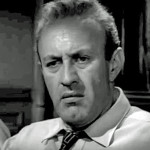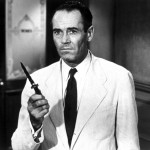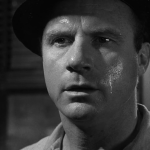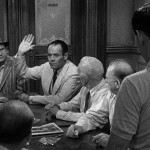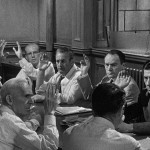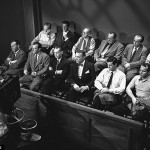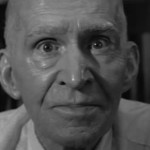Bear with me here. In the British and American system of trial by jury, deliberations in the jury room are sacrosanct. That is, they can never be revealed. The domain of the judge is the law, but the domain of the jury is the facts. The jury alone can determine what they believe to be true, which witnesses are credible and ultimately which factors are most persuasive in determining the guilt or innocence of the accused. It is the responsibility of the 12 good men and women to decide, and nobody else.
This does not mean juries always get it right, and since we have no way of knowing what is actually said or debated in the jury room we can never know whether the contentious issues are even discussed or whether the verdict is merely the product of prejudice and perversity. Who knows, maybe some juries talk about football scores in order to spread their deliberations out as long as possible?
That is the lottery of the jury system: the mix of jurors is completely random – here in the UK at least. In American trials both prosecution and defence have the right to interrogate potential jurors and excuse those they believe will be prejudiced against their case – but the decision is still up in the air until that dreaded moment when the jurors enter their room; time passes and eventually there is a decision on which they are nominally all agreed – or in some cases by a margin of 11 to 1 or 10 to 2.
In this context, the portrayal of how an American jury decides within 12 Angry Men is but one of an infinite range of possibilities, but a dramatically excellent one. How so? As the weary judge sends the jury (12 white men in this case, this being 1957) and tells them to come up with a verdict on which they are all agreed. On first ballot, 11 think the accused is guilty as hell, but only one believes there is a reasonable doubt, an architect played by Henry Fonda.
But for all but a couple of minutes right at the end, the film depicts Fonda and his fellow jurors (known only by their juror numbers) analysing the key evidence, raising doubts by comparing the stated facts against their own experience, putting psychological pressure on one another, experiencing the dynamics of decision-making by committee until, one by one, they gradually accept that there is room for doubt and even the most black-and-white closed mind finally accepts a not guilty verdict, in accordance with their responsibilities to the court.
Each fragment of evidence and argument is subjected to forensic debate until doubts begin to emerge. What was the impact of the passing train? How good was the witness’s hearing and another’s eyesight? How long would it take the old man with the game leg to get from his window to his front door, at what angle would a shorter man stab to death a much taller man? What seemed at first sight a damning case unravels in the face of examination by Fonda and other increasingly sceptical jury members. What, you might justifiably ask, was the boy’s lawyer up to – surely he should have been asking those questions under cross-examination?
Depending on the jury, this could have been a highly mundane encounter, yet in practice it proves to be engaging and downright fascinating, in part because of the finely-honed characters and script devised by Reginald Rose, such that each has a story to tell, informing their views and their justifications. The psychology of the characters, forced to share the claustrophobic jury room and fulfil their duty is the riveting subtext to this film, especially where they reach impasse and a verdict seems impossible (full plot below, courtesy of Wikipedia.) At times it seems likely to come to blows, but reason wins out above emotion, in spite of the high tensions created.
With nothing more than the room for a set, director Sidney Lumet (for it is he, directing the debut feature of a glittering career including Network, Equus, Serpico and Murder on the Orient Express) constructs a compelling drama through excellent cinematography and judicious use of both wide angle and telephoto lenses to enhance the claustrophobic impact.
In this task he is aided not just by the very distinguished Fonda but a fine cast of character actors, many of whom went on to become cherished in their own right. Remember Jack Klugman from the TV adaptation of The Odd Couple? Then there’s Ed Begley Sr, Lee J Cobb, John Fiedler, Martin Balsam (Arbogast in Psycho) and a host of other familiar faces. That they are familiar is not the key point – they are all convincing in their roles and how they bounce off one another.
Of its type it’s not the first or only courtroom drama, nor yet the only film focusing on the works of a jury, but it is unmistakably a classic of the genre and unquestionably influenced many other courtroom dramas along the way.
___________________________
The story begins in a New York City courthouse, where an eighteen-year-old boy from a slum is on trial for allegedly stabbing his father to death. Final closing arguments having been presented, a visibly tired judge instructs the jury to decide whether the boy is guilty of murder. The judge further informs them that a guilty verdict will be accompanied by a mandatory death sentence.
The jury retires to a private room, where the jurors spend a short while getting acquainted before they begin deliberating. It is immediately apparent that the jurors have already decided that the boy is guilty, and that they plan to return their verdict without taking time for discussion—with the sole exception of Juror 8 (Henry Fonda), who is the only “not guilty” vote in a preliminary tally. He explains that there is too much at stake for him to go along with the verdict without at least talking about it first. His vote annoys the other jurors, especially Juror 7 (Jack Warden), who has tickets to a baseball game that evening; and Juror 10 (Ed Begley), who believes that people from slum backgrounds are liars and are wild and dangerous.
The rest of the film’s focus is the jury’s difficulty in reaching a unanimous verdict. While several of the jurors harbor personal prejudices, Juror 8 maintains that the evidence presented in the case is circumstantial, and that the boy deserves a fair deliberation. He calls into question the accuracy and reliability of the only two witnesses to the murder, the “rarity” of the murder weapon (a common switchblade, of which he has an identical copy), and the overall questionable circumstances. He further argues that he cannot in good conscience vote “guilty” when he feels there is reasonable doubt of the boy’s guilt.
Having argued several points and gotten no favorable response from the others, Juror 8 reluctantly agrees that he has only succeeded in hanging the jury. Instead, he requests another vote, this time by secret ballot. He proposes that he will abstain from voting, and if the other 11 jurors are still unanimous in a guilty vote, then he will acquiesce to their decision. The secret ballot is held, and a new “not guilty” vote appears. This earns intense criticism from Juror 3 (Lee J. Cobb), who blatantly accuses Juror 5 (Jack Klugman) – who had grown up in a slum – of switching out of sympathy toward slum children. However, Juror 9 (Joseph Sweeney) reveals that he himself changed his vote, feeling that Juror 8’s points deserve further discussion.
Juror 8 presents a convincing argument that one of the witnesses, an elderly man who claimed to have heard the boy yell “I’m going to kill you” shortly before the murder took place, could not have heard the voices as clearly as he had testified due to an elevated train passing by at the time; as well as stating that “I’m going to kill you,” is often said by people who do not literally mean it. Juror 5 changes his vote to “not guilty”. Soon afterward, Juror 11 (George Voskovec) questions whether the defendant would have reasonably fled the scene before cleaning the knife of fingerprints, then come back three hours later to retrieve the knife (which had been left in his father’s chest). Juror 11 then changes his vote.
Juror 8 then mentions the man’s second claim: upon hearing the father’s body hit the floor, he had run to the door of his apartment and seen the defendant running out of the building from his front door in 15 seconds. Jurors 5, 6 and 8 question whether this is true, as the witness in question had had a stroke, limiting his ability to walk. Upon the end of an experiment, the jury finds that the witness would not have made it to the door in enough time to actually see the killer running out. Juror 8 concludes that, judging from what he claims to have heard earlier, the witness must have merely assumed it was the defendant running. Juror 3, growing more irritated throughout the process, explodes in a rant: “He’s got to burn! He’s slipping through our fingers!” Juror 8 takes him to task, calling him a “self-appointed public avenger” and a sadist, saying he wants the defendant to die because of personal desire rather than the facts. Juror 3 shouts “I’ll kill him!” and starts lunging at Juror 8, but is restrained by Jurors 5 and 7. Juror 8 calmly retorts, “You don’t really mean you’ll kill me, do you?”, proving his previous point.
Jurors 2 (John Fiedler) and 6 (Edward Binns) also decide to vote “not guilty”, tying the vote at 6–6. Soon after, a rainstorm hits the city, threatening to cancel the baseball game for which Juror 7 has tickets.
Juror 4 (E. G. Marshall) states that he does not believe the boy’s alibi, which was being at the movies with a few friends at the time of the murder, because the boy could not remember what movie he had seen when questioned by police shortly after the murder. Juror 8 explains that being under emotional stress can make you forget certain things, and tests how well Juror 4 can remember the events of previous days. Juror 4 remembers, with some difficulty, the events of the previous five days, and Juror 8 points out that he had not been under emotional stress at that time, thus there was no reason to think the boy could remember the movie that he had seen.
Juror 2 calls into question the prosecution’s claim that the accused, who was 5’7″ tall, was able to inflict the downward stab wound found on his father, who was 6’2″. Jurors 3 and 8 conduct an experiment to see if it’s possible for a shorter person to stab downward into a taller person. The experiment proves the possibility, but Juror 5 then explains that he had grown up amidst knife fights in his neighborhood, and shows, through demonstrating the correct use of a switchblade, that no one so much shorter than his opponent would have held a switchblade in such a way as to stab downward, as the grip would have been too awkward and the act of changing hands too time-consuming. Rather, someone that much shorter than his opponent would stab underhanded at an upwards angle. This revelation augments the certainty of several of the jurors in their belief that the defendant is not guilty.
Increasingly impatient, Juror 7 changes his vote just so that the deliberation may end, which earns him the ire of Jurors 3 and 11, both on opposite sides of the discussion. Juror 11, an immigrant who has repeatedly displayed strong patriotic pride, presses Juror 7 hard about using his vote frivolously, and eventually Juror 7 claims that he now truly believes the defendant is not guilty.
The next jurors to change their votes are Jurors 12 (Robert Webber) and 1 (Martin Balsam), making the vote 9–3 and leaving only three dissenters: Jurors 3, 4 and 10. Outraged at how the proceedings have gone, Juror 10 goes into a rage on why people from the slums cannot be trusted, of how they are little better than animals who gleefully kill each other off for fun. His speech offends Juror 5, who turns his back to him, and one by one the rest of the jurors start turning away from him. Confused and disturbed by this reaction to his diatribe, Juror 10 continues in a steadily fading voice and manner, slowing to a stop with “Listen to me. Listen…” Juror 4, the only man still facing him, tersely responds, “I have. Now sit down and don’t open your mouth again.” As Juror 10 moves to sit in a corner by himself, Juror 8 speaks quietly about the evils of prejudice, and the other jurors slowly resume their seats.
When those remaining in favor of a guilty vote are pressed as to why they still maintain that there is no reasonable doubt, Juror 4 states his belief that despite all the other evidence that has been called into question, the fact remains that the woman who saw the murder from her bedroom window across the street (through the passing train) still stands as solid evidence. After he points this out, Juror 12 changes his vote back to “guilty”, making the vote 8–4.
Then Juror 9, after seeing Juror 4 rub his nose (which is being irritated by his glasses), realizes that, like Juror 4, the woman who allegedly saw the murder had impressions in the sides of her nose which she rubbed, indicating that she wore glasses, but did not wear them to court out of vanity. Juror 8 cannily asks Juror 4 if he wears his eyeglasses to sleep, and Juror 4 admits that he does not wear them – nobody does. Juror 8 explains that there was thus no logical reason to expect that the witness happened to be wearing her glasses while trying to sleep, and he points out that the attack happened so swiftly that she would not have had time to put them on. After he points this out, Jurors 12, 10 and 4 all change their vote to “not guilty”.
At this point, the only remaining juror with a guilty vote is Juror 3. Juror 3 gives a long and increasingly tortured string of arguments, ending with, “Rotten kids, you work your life out—!” This builds on a more emotionally ambivalent earlier revelation that his relationship with his own son is deeply strained, and his anger over this fact is the main reason that he wants the defendant to be guilty. Juror 3 finally loses his temper and tears up a photo of himself and his son, then suddenly breaks down crying and changes his vote to “not guilty”, making the vote unanimous.
As the jurors leave the room, Juror 8 helps the distraught Juror 3 with his coat in a show of compassion. The film ends when the friendly Jurors 8 (Davis) and 9 (McCardle) exchange names, and all of the jurors descend the courthouse steps to return to their individual lives.


